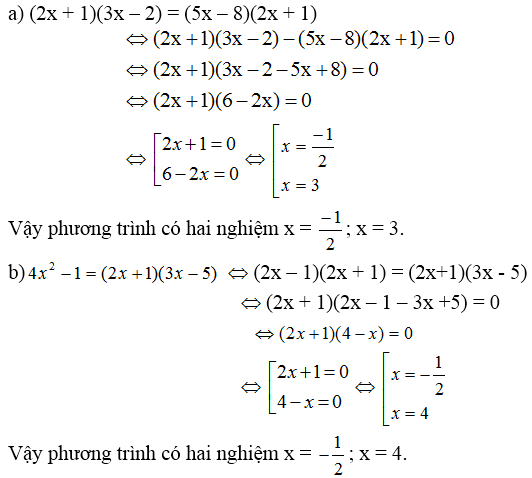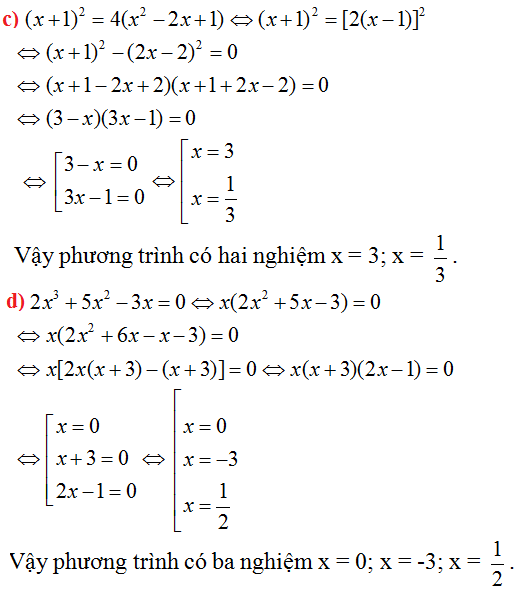Giải phương trình đưa về dạng tích : \(4x^2-1=\left(2x+1\right)\left(3x-5\right)\)

Những câu hỏi liên quan
Giải các phương trình sau bằng cách đưa về phương trình tích :
a) \(\left(2x+1\right)\left(3x-2\right)=\left(5x-8\right)\left(2x+1\right)\)
b) \(4x^2-1=\left(2x+1\right)\left(3x-5\right)\)
c) \(\left(x+1\right)^2=4\left(x^2-2x+1\right)\)
d) \(2x^3+5x^2-3x=0\)
a)(2x+1)(3x-2)=(5x-8)(2x+1)
⇔(2x+1)(3x-2)-(5x-8)(2x+1)=0
⇔(2x+1)(3x-2-5x+8)=0
⇔(2x+1)(-2x+6)=0
⇔2x+1=0 hoặc -2x+6=0
1.2x+1=0⇔2x=-1⇔x=-1/2
2.-2x+6=0⇔-2x=-6⇔x=3
phương trình có 2 nghiệm x=-1/2 và x=3
Đúng 0
Bình luận (0)
b)4x2-1=(2x+1)(3x-5)
⇔(2x-1)(2x+1)-(2x+1)(3x-5)=0
⇔(2x+1)(2x-1-3x+5)=0
⇔(2x+1)(-x+4)=0
⇔2x+1=0 hoặc -x+4=0
1.2x+1=0⇔2x=-1⇔x=-1/2
2.-x+4=0⇔-x=-4⇔x=4
phương trình có 2 nghiệm x=-1/2 và x=4
Đúng 0
Bình luận (0)
Giải các phương trình sau bằng cách đưa về phương trình tích:
a, \(9x^2-1=\left(3x+1\right)\left(2x-1\right)\)
b, \(\left(4x-3\right)^2=4\left(x^2-2x+1\right)\)
a) \(9x^2-1=\left(3x+1\right)\left(2x-1\right)\)
\(\Rightarrow\left(3x+1\right)\left(3x-1\right)=\left(3x+1\right)\left(2x-1\right)\)
\(\Leftrightarrow\left(3x+1\right)\left(3x-1\right)-\left(3x+1\right)\left(2x-1\right)=0\)
\(\Leftrightarrow\left(3x+1\right)\left(3x-1-2x+1\right)=0\)
\(\Leftrightarrow x\left(3x+1\right)=0\)
\(\Leftrightarrow\orbr{\begin{cases}x=0\\3x+1=0\end{cases}}\Leftrightarrow\orbr{\begin{cases}x=0\\x=\frac{-1}{3}\end{cases}}\)
b) \(\left(4x-3\right)^2=4\left(x^2-2x+1\right)\)
\(\Leftrightarrow16x^2-24x+9=4x^2-8x+4\)
\(\Leftrightarrow12x^2-16x+5=0\)
Ta có \(\Delta=16^2-4.12.5=16,\sqrt{\Delta}=4\)
\(\Rightarrow\orbr{\begin{cases}x=\frac{16+4}{12}=\frac{5}{3}\\x=\frac{16-4}{12}=1\end{cases}}\)
bài 1. giải các phương trình saua / x (4x+1) (frac{3x+7}{3-5x}+1)(x+4)(frac{3x+7}{5x-3}-1)b/ left(x^2+3x+1right)left(frac{4x-3}{3x+1}+2right)left(4x+7right)left(frac{4x-3}{3x+1}+2right)1)bài 2. giải phương trình sau bằng cách đưa về phương trình tícha/left(4x-5right)^2-2left(16x^2-25right)0b/ left(4x+3right)^24left(x^2-2x+1right)c. 3x^3-3x^2-6x0cảm ơn mọi người nhiều lắm !
Đọc tiếp
bài 1. giải các phương trình sau
a / \(x =(4x+1) (\frac{3x+7}{3-5x}+1)=(x+4)(\frac{3x+7}{5x-3}-1)\)
b/ \(\left(x^2+3x+1\right)\left(\frac{4x-3}{3x+1}+2\right)=\left(4x+7\right)\left(\frac{4x-3}{3x+1}+2\right)\)1)
bài 2. giải phương trình sau bằng cách đưa về phương trình tích
a/\(\left(4x-5\right)^2-2\left(16x^2-25\right)=0\)
b/ \(\left(4x+3\right)^2=4\left(x^2-2x+1\right)\)
c. \(3x^3-3x^2-6x=0\)
cảm ơn mọi người nhiều lắm !
Giải các phương trình bằng cách đưa về phương trình tích:
a) \(\left(3x^2-7x-10\right)\left[2x^2+\left(1-\sqrt{5}\right)x+\sqrt{5}-3\right]=0;\)
b) \(x^3+3x^2-2x-6=0;\)
c) \(\left(x^2-1\right)\left(0,6x+1\right)=0,6x^2+x;\)
d) \(\left(x^2+2x-5\right)^2=\left(x^2-x+5\right)^2.\)
a) (3x2 - 7x – 10)[2x2 + (1 - √5)x + √5 – 3] = 0
=> hoặc (3x2 - 7x – 10) = 0 (1)
hoặc 2x2 + (1 - √5)x + √5 – 3 = 0 (2)
Giải (1): phương trình a - b + c = 3 + 7 - 10 = 0
nên
x1 = - 1, x2 = =
Giải (2): phương trình có a + b + c = 2 + (1 - √5) + √5 - 3 = 0
nên
x3 = 1, x4 =
b) x3 + 3x2– 2x – 6 = 0 ⇔ x2(x + 3) – 2(x + 3) = 0 ⇔ (x + 3)(x2 - 2) = 0
=> hoặc x + 3 = 0
hoặc x2 - 2 = 0
Giải ra x1 = -3, x2 = -√2, x3 = √2
c) (x2 - 1)(0,6x + 1) = 0,6x2 + x ⇔ (0,6x + 1)(x2 – x – 1) = 0
=> hoặc 0,6x + 1 = 0 (1)
hoặc x2 – x – 1 = 0 (2)
(1) ⇔ 0,6x + 1 = 0
⇔ x2 = =
(2): ∆ = (-1)2 – 4 . 1 . (-1) = 1 + 4 = 5, √∆ = √5
x3 = , x4 =
Vậy phương trình có ba nghiệm:
x1 = , x2 =
, x3 =
,
d) (x2 + 2x – 5)2 = ( x2 – x + 5)2 ⇔ (x2 + 2x – 5)2 - ( x2 – x + 5)2 = 0
⇔ (x2 + 2x – 5 + x2 – x + 5)( x2 + 2x – 5 - x2 + x - 5) = 0
⇔ (2x2 + x)(3x – 10) = 0
⇔ x(2x + 1)(3x – 10) = 0
Hoặc x = 0, x = , x =
Vậy phương trình có 3 nghiệm:
x1 = 0, x2 = , x3 =
Đúng 0
Bình luận (0)
giải các phương trình sau
a) \(\log_3\left(2x-5\right)=3\)
b) \(\log_4x^2=2\)
c) \(\log_7\left(3x-1\right)=\log_7\left(2x+5\right)\)
d) \(\ln\left(4x^2+2x-3\right)=\ln\left(3x^2-3\right)\)
e) \(\log\left(2x+3\right)=log\left(1-3x\right)\)
a: ĐKXĐ: \(x\notin\left\{\dfrac{5}{2}\right\}\)
\(\log_32x-5=3\)
=>\(log_3\left(2x-5\right)=log_327\)
=>2x-5=27
=>2x=32
=>x=16(nhận)
b: ĐKXĐ: x<>0
\(\log_4x^2=2\)
=>\(log_4x^2=log_416\)
=>\(x^2=16\)
=>\(\left[{}\begin{matrix}x=4\left(nhận\right)\\x=-4\left(nhận\right)\end{matrix}\right.\)
c: ĐKXĐ: \(x\notin\left\{\dfrac{1}{3};-\dfrac{5}{2}\right\}\)
\(\log_7\left(3x-1\right)=\log_7\left(2x+5\right)\)
=>3x-1=2x+5
=>x=6(nhận)
d: ĐKXĐ: \(x\notin\left\{1;-1;\dfrac{-1+\sqrt{13}}{4};\dfrac{-1-\sqrt{13}}{4}\right\}\)
\(ln\left(4x^2+2x-3\right)=ln\left(3x^2-3\right)\)
=>\(4x^2+2x-3=3x^2-3\)
=>\(x^2+2x=0\)
=>x(x+2)=0
=>\(\left[{}\begin{matrix}x=0\\x+2=0\end{matrix}\right.\Leftrightarrow\left[{}\begin{matrix}x=0\left(nhận\right)\\x=-2\left(nhận\right)\end{matrix}\right.\)
e: ĐKXĐ: \(x\notin\left\{-\dfrac{3}{2};\dfrac{1}{3}\right\}\)
\(log\left(2x+3\right)=log\left(1-3x\right)\)
=>2x+3=1-3x
=>5x=-2
=>\(x=-\dfrac{2}{5}\left(nhận\right)\)
Đúng 1
Bình luận (0)
Giải các phương trình sau đây bằng cách đưa về dạng phương trình tích :
a) \(\left(x-\sqrt{2}\right)+3\left(x^2-2\right)=0\)
b) \(x^2-5=\left(2x-\sqrt{5}\right)\left(x+\sqrt{5}\right)\)
Giải các bất phương trình, hệ phương trìnha) dfrac{x^2-4x+3}{2x-3}ge x-1b) 3x^2-left|4x^2+x-5right|3c)4x-left|2x^2-8x-15right|le-1d)x+3-sqrt{21-4x-x^2}ge0e)left{{}begin{matrix}xleft(x+5right) 4x+2left(2x-1right)left(x+3right)ge4xend{matrix}right.f)dfrac{1}{x^2-5x+4}ledfrac{1}{x^2-7x+10}
Đọc tiếp
Giải các bất phương trình, hệ phương trình
a) \(\dfrac{x^2-4x+3}{2x-3}\ge x-1\)
b) \(3x^2-\left|4x^2+x-5\right|>3\)
c)\(4x-\left|2x^2-8x-15\right|\le-1\)
d)\(x+3-\sqrt{21-4x-x^2}\ge0\)
e)\(\left\{{}\begin{matrix}x\left(x+5\right)< 4x+2\\\left(2x-1\right)\left(x+3\right)\ge4x\end{matrix}\right.\)
f)\(\dfrac{1}{x^2-5x+4}\le\dfrac{1}{x^2-7x+10}\)
Giải các phương trình sau:1, dfrac{x-1}{3}-xdfrac{2x-4}{4}2, left(x-2right)left(2x-1right)x^2-2x3, 3x^2-4x+104, left|2x-4right|05, left|3x+2right|46, left|2x-5right|left|-x+2right|*Giúp mình với mình đg cần gấp ạ T_T
Đọc tiếp
Giải các phương trình sau:
1, \(\dfrac{x-1}{3}-x=\dfrac{2x-4}{4}\)
2, \(\left(x-2\right)\left(2x-1\right)=x^2-2x\)
3, \(3x^2-4x+1=0\)
4, \(\left|2x-4\right|=0\)
5, \(\left|3x+2\right|=4\)
6, \(\left|2x-5\right|=\left|-x+2\right|\)
*Giúp mình với mình đg cần gấp ạ T_T
\(1.\dfrac{x-1}{3}-x=\dfrac{2x-4}{4}.\Leftrightarrow\dfrac{x-1-3x}{3}=\dfrac{x-2}{2}.\Leftrightarrow\dfrac{-2x-1}{3}-\dfrac{x-2}{2}=0.\)
\(\Leftrightarrow\dfrac{-4x-2-3x+6}{6}=0.\Rightarrow-7x+4=0.\Leftrightarrow x=\dfrac{4}{7}.\)
\(2.\left(x-2\right)\left(2x-1\right)=x^2-2x.\Leftrightarrow\left(x-2\right)\left(2x-1\right)-x\left(x-2\right)=0.\)
\(\Leftrightarrow\left(x-2\right)\left(2x-1-x\right)=0.\Leftrightarrow\left(x-2\right)\left(x-1\right)=0.\)
\(\Leftrightarrow\left[{}\begin{matrix}x=2.\\x=1.\end{matrix}\right.\)
\(3.3x^2-4x+1=0.\Leftrightarrow\left(x-1\right)\left(x-\dfrac{1}{3}\right)=0.\Leftrightarrow\left[{}\begin{matrix}x=1.\\x=\dfrac{1}{3}.\end{matrix}\right.\)
\(4.\left|2x-4\right|=0.\Leftrightarrow2x-4=0.\Leftrightarrow x=2.\)
\(5.\left|3x+2\right|=4.\Leftrightarrow\left[{}\begin{matrix}3x+2=4.\\3x+2=-4.\end{matrix}\right.\Leftrightarrow\left[{}\begin{matrix}x=\dfrac{2}{3}.\\x=-2.\end{matrix}\right.\)
Đúng 1
Bình luận (2)
\(1,\dfrac{x-1}{3}-x=\dfrac{2x-4}{4}\\ \Leftrightarrow\dfrac{x-1}{3}-x=\dfrac{x-2}{2}\\ \Leftrightarrow\dfrac{2\left(x-1\right)-6x}{6}=\dfrac{3\left(x-2\right)}{6}\\ \Leftrightarrow2\left(x-1\right)-6x=3\left(x-2\right)\\ \Leftrightarrow2x-2-6x=3x-6\\ \Leftrightarrow-4x-2=3x-6\)
\(\Leftrightarrow3x-6+4x+2=0\\ \Leftrightarrow7x-4=0\\ \Leftrightarrow x=\dfrac{4}{7}\)
\(2,\left(x-2\right)\left(2x-1\right)=x^2-2x\\ \Leftrightarrow2x^2-4x-x+2=x^2-2x\\ \Leftrightarrow x^2-3x+2=0\\ \Leftrightarrow\left(x^2-2x\right)-\left(x-2\right)=0\\ \Leftrightarrow x\left(x-2\right)-\left(x-2\right)=0\\ \Leftrightarrow\left(x-1\right)\left(x-2\right)=0\\ \Leftrightarrow\left[{}\begin{matrix}x=1\\x=2\end{matrix}\right.\)
\(3,3x^2-4x+1=0\\ \Leftrightarrow\left(3x^2-3x\right)-\left(x-1\right)=0\\ \Leftrightarrow3x\left(x-1\right)-\left(x-1\right)=0\\ \Leftrightarrow\left(x-1\right)\left(3x-1\right)=0\\ \Leftrightarrow\left[{}\begin{matrix}x=1\\x=\dfrac{1}{3}\end{matrix}\right.\)
\(4,\left|2x-4\right|=0\\ \Leftrightarrow2x-4=0\\ \Leftrightarrow2x=4\\ \Leftrightarrow x=2\)
\(5,\left|3x+2\right|=4\\ \Leftrightarrow\left[{}\begin{matrix}3x+2=4\\3x+2=-4\end{matrix}\right.\\ \Leftrightarrow\left[{}\begin{matrix}3x=2\\3x=-6\end{matrix}\right.\\ \Leftrightarrow\left[{}\begin{matrix}x=\dfrac{2}{3}\\x=-2\end{matrix}\right.\)
\(6,\left|2x-5\right|=\left|-x+2\right|\\ \Leftrightarrow\left[{}\begin{matrix}2x-5=-x+2\\2x-5=x-2\end{matrix}\right.\\ \Leftrightarrow\left[{}\begin{matrix}3x=7\\x=3\end{matrix}\right.\\ \Leftrightarrow\left[{}\begin{matrix}x=\dfrac{7}{3}\\x=3\end{matrix}\right.\)
Đúng 0
Bình luận (0)
Bài tập. Giải các phương trình sau:
a) \(\left|7-x\right|+2x=3\)
b) \(\left|2x-3\right|-4x-9=0\)
c) \(\left|3x+5\right|=\left|2-5x\right|\)
d) \(x\left|x-3\right|-\left|x^2+x+1\right|=1\)
a: =>|x-7|=3-2x
\(\Leftrightarrow\left\{{}\begin{matrix}x< =\dfrac{3}{2}\\\left(-2x+3\right)^2-\left(x-7\right)^2=0\end{matrix}\right.\)
\(\Leftrightarrow\left\{{}\begin{matrix}x< =\dfrac{3}{2}\\\left(2x-3-x+7\right)\left(2x-3+x-7\right)=0\end{matrix}\right.\)
\(\Leftrightarrow\left\{{}\begin{matrix}x< =\dfrac{3}{2}\\\left(x+4\right)\left(3x-10\right)=0\end{matrix}\right.\Leftrightarrow x=-4\)
b: =>|2x-3|=4x+9
\(\Leftrightarrow\left\{{}\begin{matrix}x>=-\dfrac{9}{4}\\\left(4x+9-2x+3\right)\left(4x+9+2x-3\right)=0\end{matrix}\right.\)
\(\Leftrightarrow\left\{{}\begin{matrix}x>=-\dfrac{9}{4}\\\left(2x+12\right)\left(6x+6\right)=0\end{matrix}\right.\Leftrightarrow x=-1\)
c: =>3x+5=2-5x hoặc 3x+5=5x-2
=>8x=-3 hoặc -2x=-7
=>x=-3/8 hoặc x=7/2
Đúng 5
Bình luận (0)
























